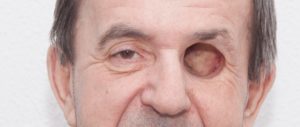 Losing any part of the body is traumatic, but there is perhaps nothing more traumatic than losing or damaging part of the face. The face is the first thing everyone sees, and it is what expresses our feelings, our personalities, our very selves. It used to be that there was nothing much that could be done for people who had lost an eye or a nose, but that’s not the case anymore. Now, medical professionals are capable of 3D printing a prosthetic eye or nose for patients who have lost them or were born without them. While a 3D printed prosthetic eye may not allow a patient to see again – we’re not quite there yet – these prosthetics look so real that it’s almost impossible to tell that the patient’s face was damaged in the first place.
Losing any part of the body is traumatic, but there is perhaps nothing more traumatic than losing or damaging part of the face. The face is the first thing everyone sees, and it is what expresses our feelings, our personalities, our very selves. It used to be that there was nothing much that could be done for people who had lost an eye or a nose, but that’s not the case anymore. Now, medical professionals are capable of 3D printing a prosthetic eye or nose for patients who have lost them or were born without them. While a 3D printed prosthetic eye may not allow a patient to see again – we’re not quite there yet – these prosthetics look so real that it’s almost impossible to tell that the patient’s face was damaged in the first place.
Istok Audio is a Russian company known for its hearing aids, but it also provides a wide range of other medical products, including facial prosthetics, which it offers through its subsidiary Protez Studio. In December of 2017, Istok Audio purchased a Drake Mini 3D scanner from Thor3D. The company was looking to use 3D scanning to create more realistic facial prosthetics.
A technician will scan the affected part of the patient’s face, then post-process the scan in Thor3D suite and export it to Blender and Meshmixer to create a custom prosthetic. The scanning itself takes about five minutes, while the post-processing takes only about 15-20 minutes. Istok Audio gets a lot of use out of the 3D scanner, using it three to five times a week to make custom prosthetics for patients.
“Initially, post processing of the models took around 30 minutes,” said Sergey Gladchenko, Head of the Production Department. “We invested in a new, powerful laptop and the processing time was reduced in half.”
Once the model is completed, it is 3D printed on an SLA 3D printer from 3DSLA.
“Our company also owns Rapidshape and EnvisionTEC printers, and those can also be used for the printing of the mold, but their higher quality and price of materials is not necessary for this application,” explained Gladchenko.
When the final prosthetic is complete, it is fitted to the patient to make sure that it is comfortable and incorporates seamlessly into the patient’s face. These prosthetics are often received with amazement at how realistic they are; the 3D scanning process allows them to mimic the patient’s original missing feature almost perfectly. It doesn’t take long, either, despite the detail and realism. Even working with children, who are difficult to keep still during a scan, is easy with the Drake Mini 3D scanner.
“The most useful aspect of using the Drake Mini scanner was the significant reduction in time when scanning our youngest clients,” said Gladchenko. “Working with children was always rewarding, but now is also simple because scanning is quick and even if the patient moves during the process, the software can correct for that.”
A facial prosthetic is much quicker than full reconstructive surgery, as well as less invasive, and requires no recovery time. There’s also no risk of rejection. We may eventually see a day, with all the advances being made in bioprinting, when medical professionals can actually recreate a functioning organ like an eye or nose to replace one that is missing, but until then, 3D scanning and 3D printing allow for prosthetics that look just like the real thing.
Discuss this and other 3D printing topics at 3DPrintBoard.com or share your thoughts below.
[Images provided by Thor3D]
Subscribe to Our Email Newsletter
Stay up-to-date on all the latest news from the 3D printing industry and receive information and offers from third party vendors.
You May Also Like
HILOS Realizes Footwear Designs of Ancuta Sarca with Shoe 3D Printing Platform
Designer Ancuta Sarca collaborated with HILOS Studio to unveil 3D printed shoes at London Fashion Week. Together, they created a wedge sandal that highlights Ancuta’s design prowess and HILOS’s platform-based...
HILOS Unveils On-demand 3D Printed Shoe Platform at Art Basel
At Art Basel in Miami, Portland startup HILOS Studio announced a new partnership that signals a shift in the company’s business strategy for 3D printed footwear production, likely for the...
RIP 3D Printing, Part 3: Rapid Applications
In this series, I’ve guided you through a fragmented landscape where the shift from investor funding to making money from selling components, services or machines is imminent. Traditionally, mastering 3D...
3DPOD Episode 174: 3D Printed Shoes with Elias Stahl, HILOS Founder & CEO
Elias Stahl believes that his startup, HILOS, has the potential to transform the manufacturing industry. Starting with 3D printed shoes, he aims to integrate this technology with skilled labor, additional...



































